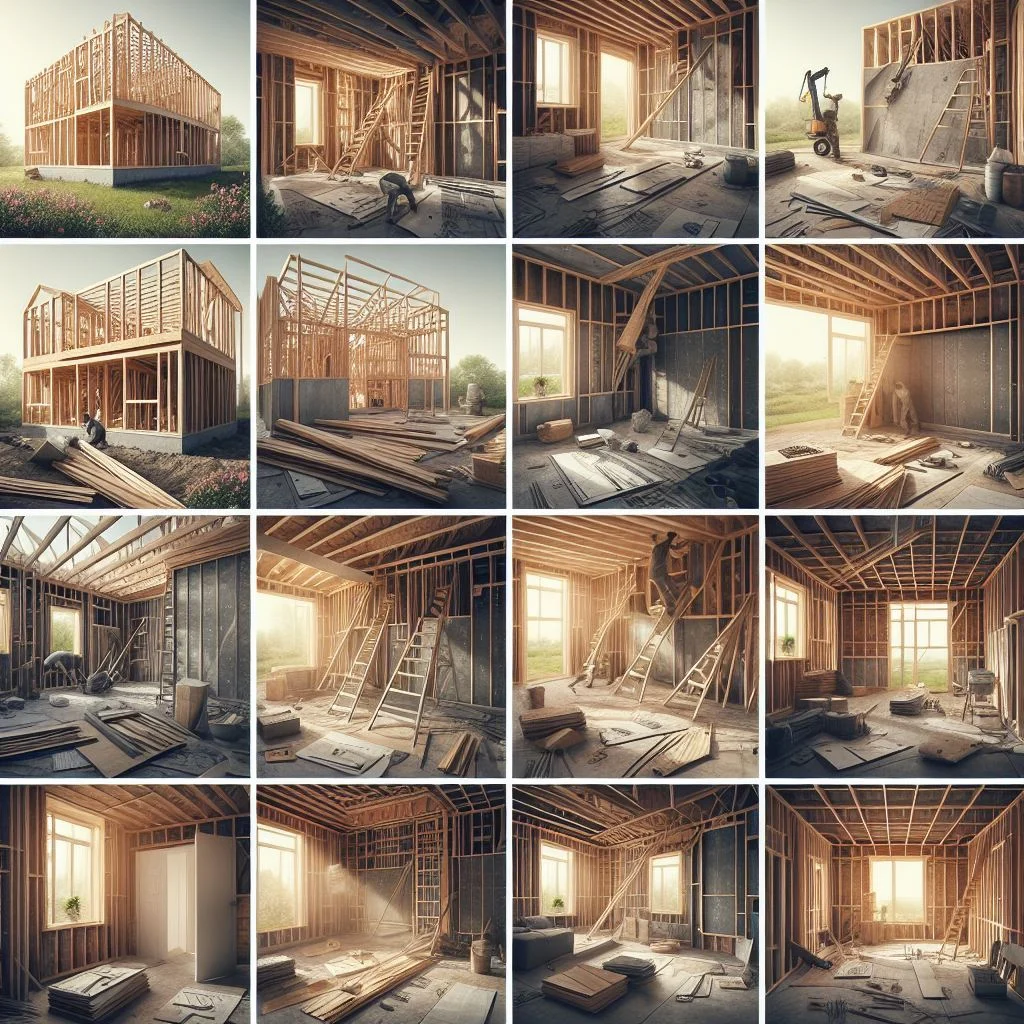Embarking on the journey of building or renovating a home is an exciting yet complex process. As the project progresses, there are key milestones that mark significant steps toward completion. One crucial phase that often piques the interest of homeowners and investors is the transition from drywall installation to the much-anticipated closing date. In this blog post, we will explore the various factors that influence the timeline from drywall to closing, shedding light on what to expect during this final stretch of the construction or renovation process.
1. Drywall Installation: A Pivotal Moment
The installation of drywall is a pivotal stage in the construction or renovation process. It marks the point where the skeleton of the structure begins to take on the appearance of a living space. The time it takes to complete this step depends on the size and complexity of the project, the availability of skilled labor, and any unforeseen challenges that may arise during installation.
2. Mudding and Taping: Attention to Detail Matters
Following drywall installation, the mudding and taping process begins. This meticulous step involves filling and smoothing the seams between drywall panels, creating a seamless surface for paint or other finishes. The timeframe for mudding and taping can vary based on the level of craftsmanship required and the size of the project.
3. Priming and Painting: Adding the Finishing Touches
Once the drywall is in place and properly prepared, priming and painting come next. The type of paint, number of coats, and any additional finishes can impact the time required for this step. Weather conditions may also play a role, as optimal painting conditions involve moderate temperatures and low humidity.
4. Flooring and Fixture Installation: Bringing the Space to Life
With the walls painted and ready, the focus shifts to flooring and fixture installation. Whether you choose hardwood, tile, carpet, or another flooring option, the installation process can influence the overall timeline. Similarly, the complexity of fixture installations, such as cabinets, countertops, and plumbing fixtures, can affect the time it takes to complete this stage.
5. Inspections and Quality Checks: Ensuring Compliance and Safety
Before closing can occur, various inspections and quality checks are typically carried out. Building code inspections, as well as assessments of electrical, plumbing, and HVAC systems, are essential to ensure compliance with regulations and safety standards. Any issues discovered during these inspections may lead to additional work and, consequently, an extended timeline.
6. Final Touches and Punch List: Addressing the Details
As the project nears completion, attention turns to the final touches and the creation of a punch list. This list details any remaining tasks or imperfections that need attention before the property is considered move-in ready. Addressing these items in a timely manner is crucial to staying on track for the closing date.
7. Closing: Crossing the Finish Line
The closing date represents the culmination of months of planning, construction, and attention to detail. It involves the transfer of ownership from the builder or seller to the buyer. Factors such as financing, legal processes, and the completion of any outstanding items on the punch list can influence the timing of the closing.
8. Communication and Collaboration: Key to Timely Completion
Throughout the entire process, effective communication and collaboration between all parties involved are crucial. Regular updates from the construction team, clear expectations, and an open dialogue can help identify and address potential delays early on. This collaborative approach fosters a sense of transparency and trust, ensuring that everyone is on the same page regarding the project’s timeline and goals.
9. Contingency Planning: Anticipating Challenges
Despite meticulous planning, unforeseen challenges can arise during construction or renovation. Weather delays, supply chain issues, or unexpected structural complications are examples of factors that can impact the timeline. Having a well-thought-out contingency plan in place can mitigate the impact of these challenges, allowing for a more resilient and adaptable project schedule.
10. Legal and Administrative Processes: Navigating the Paperwork
The closing process involves various legal and administrative steps that must be completed before ownership is officially transferred. These may include title searches, financing paperwork, and compliance with local regulations. Delays in any of these processes can affect the closing timeline, underscoring the importance of working with experienced professionals who can navigate these complexities efficiently.
11. Celebrating the Achievement: Moving In and Settling Down
As the final details are addressed and the closing date approaches, the excitement of moving into a new or newly renovated home builds. Planning for the actual move, coordinating utilities, and settling into the new space become the focus. This is a time to celebrate the achievement of bringing a vision to life and creating a living space tailored to the needs and preferences of the homeowner.
12. Post-Closing Considerations: Settling into Your New Home
After the closing date has come and gone, and the keys are officially in your hands, it’s time to settle into your new home. This period involves not only unpacking and arranging your belongings but also getting to know the ins and outs of your property. Familiarize yourself with the location of utilities, circuit breakers, and any other essential features. This phase is also an opportunity to address any post-move-in tasks or adjustments that may arise.
13. Home Maintenance and Care: Sustaining Your Investment
As you begin to enjoy your new living space, it’s crucial to implement a proactive approach to home maintenance. Regular checks on systems such as HVAC, plumbing, and electrical can help identify potential issues before they become major problems. Understanding the specific needs of your home, whether it’s a new build or a renovated property, is essential for sustaining your investment and ensuring its long-term functionality and value.
14. Community Integration: Embracing Your Surroundings
Beyond the walls of your home, integrating into the community is an essential aspect of settling into a new property. Establishing connections with neighbors, exploring local amenities, and engaging in community activities can contribute to a sense of belonging. This integration not only enhances your overall living experience but can also be beneficial for networking and creating a support system.
15. Reflection and Future Planning: Learning from the Process
As you reflect on the entire journey from drywall to closing, take the time to consider the lessons learned and the experiences gained. What worked well, and what could be improved upon for future endeavors? Documenting your insights can be valuable for future projects or renovations and can contribute to a smoother process the next time around.
Drywall Preparation
| Task |
Description |
Duration (Days) |
Start Date |
End Date |
| Site Inspection |
Assessing the drywall requirements |
2 |
2023-01-15 |
2023-01-16 |
| Material Ordering |
Procuring drywall materials |
5 |
2023-01-17 |
2023-01-21 |
| Framing Installation |
Installing the drywall framing |
7 |
2023-01-22 |
2023-01-28 |
| Electrical Wiring |
Running electrical wiring behind walls |
4 |
2023-01-29 |
2023-02-01 |
| Insulation Placement |
Placing insulation between studs |
3 |
2023-02-02 |
2023-02-04 |
| Drywall Delivery |
Receiving drywall sheets on-site |
2 |
2023-02-05 |
2023-02-06 |
| Drywall Cutting |
Cutting drywall sheets to fit |
4 |
2023-02-07 |
2023-02-10 |
| Drywall Installation |
Attaching drywall to framing |
10 |
2023-02-11 |
2023-02-20 |
| Taping and Mudding |
Applying joint compound and tape |
7 |
2023-02-21 |
2023-02-27 |
| Sanding |
Smoothing the drywall surfaces |
3 |
2023-02-28 |
2023-03-02 |
Inspection and Corrections
| Task |
Description |
Duration (Days) |
Start Date |
End Date |
| Drywall Inspection |
Assessing the quality of drywall work |
2 |
2023-03-03 |
2023-03-04 |
| Corrections |
Making necessary corrections |
5 |
2023-03-05 |
2023-03-09 |
| Re-inspection |
Confirming corrections |
3 |
2023-03-10 |
2023-03-12 |
| Final Approval |
Obtaining final approval for drywall |
2 |
2023-03-13 |
2023-03-14 |
| Coordination |
Coordinating with other trades |
4 |
2023-03-15 |
2023-03-18 |
| Painting Prep |
Preparing surfaces for painting |
3 |
2023-03-19 |
2023-03-21 |
| Primer Application |
Applying primer to the drywall surfaces |
2 |
2023-03-22 |
2023-03-23 |
| Inspection |
Inspecting primer application |
1 |
2023-03-24 |
2023-03-24 |
| Corrections |
Making primer-related corrections |
2 |
2023-03-25 |
2023-03-27 |
| Final Inspection |
Final inspection before closing |
3 |
2023-03-28 |
2023-03-30 |
Flooring Installation
| Task |
Description |
Duration (Days) |
Start Date |
End Date |
| Flooring Delivery |
Receiving flooring materials |
2 |
2023-04-01 |
2023-04-02 |
| Subfloor Preparation |
Preparing the subfloor for flooring |
4 |
2023-04-03 |
2023-04-06 |
| Flooring Installation |
Installing the chosen flooring |
8 |
2023-04-07 |
2023-04-14 |
| Baseboard Installation |
Installing baseboards |
3 |
2023-04-15 |
2023-04-17 |
| Flooring Inspection |
Quality check for flooring installation |
2 |
2023-04-18 |
2023-04-19 |
| Corrections |
Making flooring-related corrections |
3 |
2023-04-20 |
2023-04-22 |
| Final Inspection |
Final inspection of flooring |
2 |
2023-04-23 |
2023-04-24 |
| Cleaning |
Cleaning the flooring and surroundings |
2 |
2023-04-25 |
2023-04-26 |
| Flooring Approval |
Obtaining approval for flooring |
2 |
2023-04-27 |
2023-04-28 |
| Coordination |
Coordinating with other trades |
4 |
2023-04-29 |
2023-05-02 |
Fixture and Appliance Installation
| Task |
Description |
Duration (Days) |
Start Date |
End Date |
| Fixture Delivery |
Receiving fixtures and appliances |
3 |
2023-05-03 |
2023-05-05 |
| Plumbing Setup |
Setting up plumbing for fixtures |
5 |
2023-05-06 |
2023-05-10 |
| Appliance Wiring |
Electrical wiring for appliances |
4 |
2023-05-11 |
2023-05-14 |
| Fixture Installation |
Installing sinks, faucets, etc. |
7 |
2023-05-15 |
2023-05-21 |
| Appliance Installation |
Installing major appliances |
5 |
2023-05-22 |
2023-05-26 |
| Inspection |
Quality inspection of fixtures/appliances |
3 |
2023-05-27 |
2023-05-29 |
| Corrections |
Making corrections to fixtures/appliances |
2 |
2023-05-30 |
2023-05-31 |
| Final Inspection |
Final inspection of installations |
3 |
2023-06-01 |
2023-06-03 |
| Coordination |
Coordinating with other trades |
4 |
2023-06-04 |
2023-06-07 |
| Approval |
Obtaining approval for installations |
2 |
2023-06-08 |
2023-06-09 |
Final Touches and Closing
| Task |
Description |
Duration (Days) |
Start Date |
End Date |
| Final Cleanup |
Thorough cleaning of the entire property |
4 |
2023-06-10 |
2023-06-13 |
| Landscaping |
Exterior landscaping and beautification |
5 |
2023-06-14 |
2023-06-18 |
| Final Walkthrough |
Client walkthrough for final approval |
3 |
2023-06-19 |
2023-06-21 |
| Punch List |
Creating and addressing the punch list |
4 |
2023-06-22 |
2023-06-25 |
| Final Corrections |
Making final corrections and adjustments |
3 |
2023-06-26 |
2023-06-28 |
| Closing Activities |
Completion of paperwork and final tasks |
2 |
2023-06-29 |
2023-06-30 |
| Handover |
Official handover to the client |
1 |
2023-07-01 |
2023-07-01 |
| Celebration |
Celebrating the project completion |
1 |
2023-07-02 |
2023-07-02 |
| Warranty Period |
Monitoring for any post-closing issues |
Ongoing |
2023-07-03 |
– |
| Project Closure |
Officially closing the construction project |
1 |
2023-07-04 |
2023-07-04 |
Conclusion:
The period post-closing is a time for celebration, adjustment, and planning for the future. Settling into your new home involves more than just unpacking boxes; it’s about creating a comfortable and functional living space, becoming part of the community, and ensuring the long-term well-being of your investment. By approaching this phase with a thoughtful and proactive mindset, you can fully embrace the rewards of your journey from the initial vision to the realization of your dream home.


